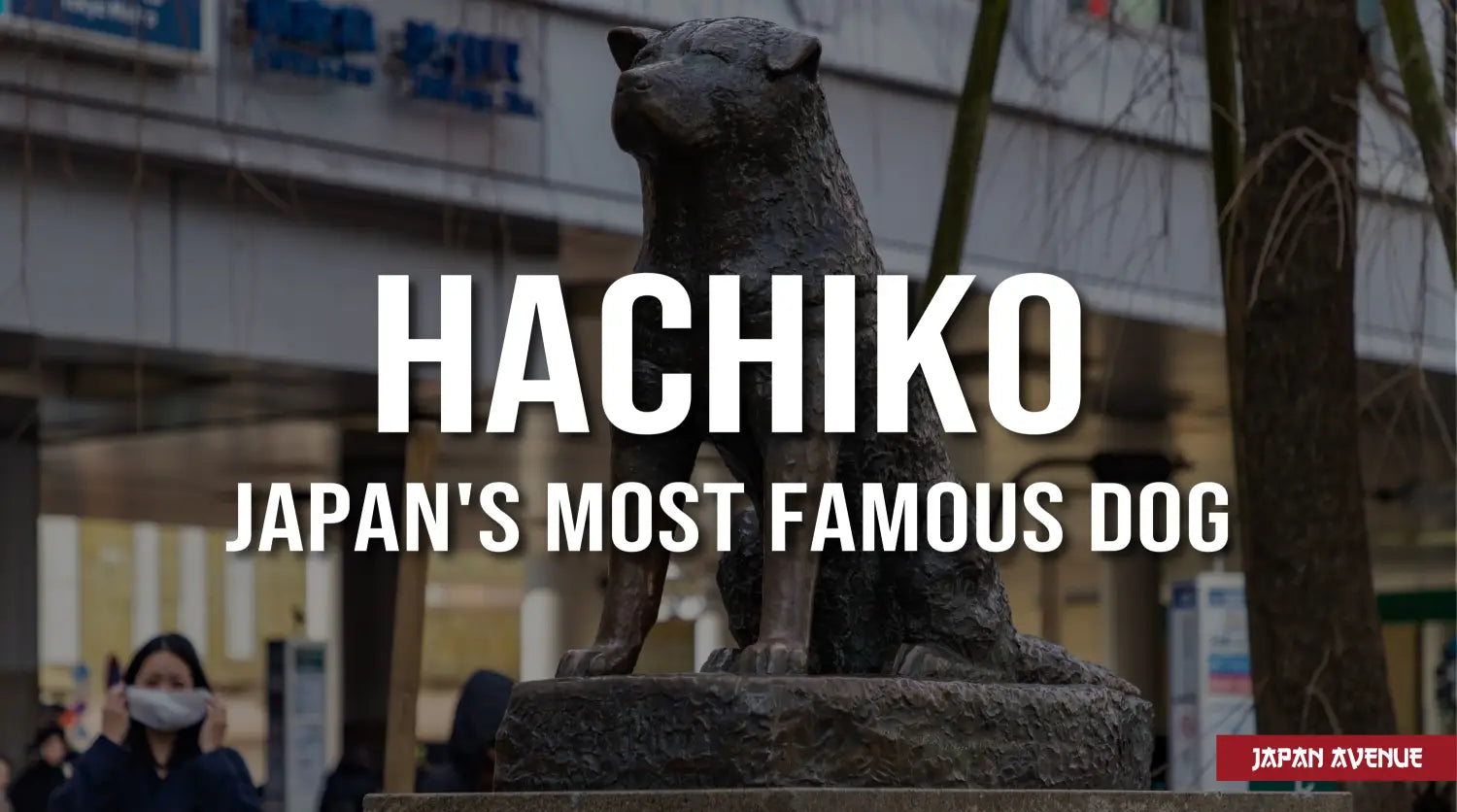When arriving in the trendy Shibuya district of Tokyo, impossible to miss the famous bronze statue of Hachiko, the most popular dog of Japan. Tourists are eagerly waiting for their turn to take a picture next to the Akita Inu. Japanese people have made it their favorite meeting point to meet their friends when they exit the subway. Even Hollywood was inspired by it for the hit movie Hachi.
Why did Hachiko's statue become a tourist attraction? Why is this dog a revered symbol for the Japanese? Discover the true story of Hachiko, who has been waiting for the return of his master for almost ten years.
Story of Hachiko, the faithful dog

Hachiko ハチ公 has two meanings in Japanese: it refers both to the eighth puppy in the litter (hachi = eight, ko = suffix used for children), but can also mean "eighth prince".
This Akita Inu dog was adopted in 1924 by Hidesaburo Ueno, a professor at the University of Tokyo who was teaching in the Agriculture Department. Born in a farm in Akita prefecture, Hachiko discovered a whole new life in Tokyo. Every day, he enjoys the morning bustle of the Shibuya district by accompanying his master to the station. A very touching way to wish the teacher good luck for his working day!
Every evening, Hachiko went back to Shibuya station by himself to welcome his beloved owner. They were inseparable. The scene of this friendly and loyal Akita taking the teacher home did not go unnoticed in the neighborhood.
Unfortunately, on the evening of May 25, 1925, Hachiko did not find his owner at the Shibuya station. That day, the teacher died of a cerebral hemorrhage while in the middle of a conference at the university.
This sad news was unacceptable for Hachiko. After the drama, he was adopted in a new home. However, as soon as the opportunity arises, he rushed to find his master. But the teacher had disappeared, his scent is no longer there, and Hachiko does not understand... From then on, he resumed his habit and went every day to the Shibuya station, watching the Japanese people getting off the train, hoping to find back Hidesaburo Ueno in the crowd of strangers.
After waiting for the teacher for almost ten years, Hachiko died in 1935 in Shibuya and marked the spirit of Japanese people forever.
The most popular dog of Japan

Passers-by and those who frequented Shibuya Station were touched by Hachiko's loyalty. To help him survive, they gave him a bit of water and food. Articles about him were written in newspapers, including one in the famous Japanese daily Asahi Shinbun in 1933: "The moving story of an old dog: 7 years of waiting for his deceased master". Hachiko became the most famous Akita Inu dog of Japan and has been the embodiment of unfailing loyalty ever since.
He was nicknamed Chuken, which means "faithful dog". In 1934, one year before his death, a bronze statue was created in his honor at the exit of the station. He thus attended the inauguration of his own monument!
On the first anniversary of his death, Tokyoites paid tribute to him by organizing a ceremony in the streets of Shibuya. This ceremony is repeated every year in April. Still today, this iconic statue continues to attract tourists and inspire the Japanese.
You may not know it, but the famous statue, proudly facing the Shibuya intersection, is not the only tribute to Hachiko:
- Hachiko-guchi: name of the subway exit in Shibuya which leads to the statue.
- National Museum of Nature and Science in Tokyo: Hachiko's fur was stuffed and is kept in this museum. Besides, all kinds of curiosities are exhibited in the cultural places of the city. If you are planning to travel to Japan and visit museums, check out the Top 12 unusual museums in the Land of the Rising Sun.
- Shirane Museum: a photograph of Hachiko wearing his harness was temporarily exhibited.
- Odate station, Akita prefecture: birthplace of Hachiko, where a statue was built in his honor in 2004. Here, we can also find the Hachiko Shrine of Japan Railways.
- Tokyo University of Agriculture and Technology: Hachiko's owner used to work there. There is a very touching statue of the dog playing with the teacher, inaugurated in 2015.
- Aoyama Cemetery: the remains of the dog rest peacefully next to the body of his owner.
- Japan's virtual pet cemetery: Hachiko has his own virtual grave. As a reminder, he is not the only animal to be venerated by the Japanese. Learn more about Japanese animals with strong symbolism.
- Hachiko bus: tourist transport line that runs in Shibuya district.
- Tributes in pop culture: we can find references to our favorite Akita in many works. In manga (Nana, One Piece, GTO), comics (Spirou in Tokyo), cartoons (Futurama, Scooby-Doo), or even in video games (The World Ends With You).

Statue of Hachiko and Hidesaburo Ueno.
Hachi, the emotional movie based on Hachiko
The most famous dog of Japan did not only appear a few minutes in an episode of anime. No, two movies are entirely dedicated to Hachiko!
In 1987, his story was told in the movie Hachiko Monogatari and deeply touched the whole of Japan. But the cult film that made his existence known worldwide is Hachi: a dog's tale, directed by Lasse Hallström and released in 2009.
From the first minutes of this Hollywood remake, the dog Hachi is presented as a hero. The tone is set and the emotion already begins to win over the viewer.
In this version, Hachiko is surrounded by mystery. His origins are unknown, he is transported in a wooden cage from Japan to the United States. During the journey, the dog's cage falls and poor Hachiko gets lost on a train platform. He is then taken in by Parker (Richard Gere), a music teacher who was on his way home from college.
The dog occupies a very important place in the film, because many scenes are shot from his point of view, in black and white. We see him grow up, learn to fetch the ball, become attached to his master and end up accompanying him every day to the train station. Hachi is thus a character in his own right, which allows us to understand and share his emotions. But, now that you know the true story of Hachiko, you unfortunately have an idea of the heartbreaking end of the movie...
Some dog lovers are afraid to watch the movie for fear of shedding tears. The craze for Hachi is always present, as proven by all the emotional reactions of the viewers who (re)discovered the work on Netflix in 2022.

As for Hachiko's true story, it is still used today by Japanese teachers to explain the notion of loyalty to their students. If you happen to visit Shibuya, please wave at the famous statue on our behalf!




1 comment
Светлана
Hello, could you tell us more about the life of Hachiko and Hidasaburo Ueno? How did they live before the tragedy? What was their relationship like? How much did Hidasaburo love Hachiko?
Hello, could you tell us more about the life of Hachiko and Hidasaburo Ueno? How did they live before the tragedy? What was their relationship like? How much did Hidasaburo love Hachiko?